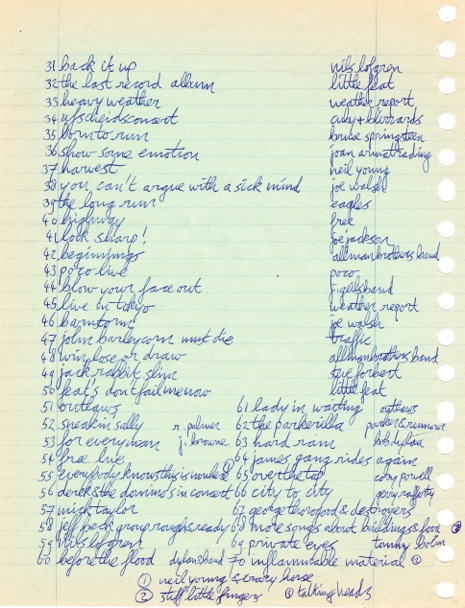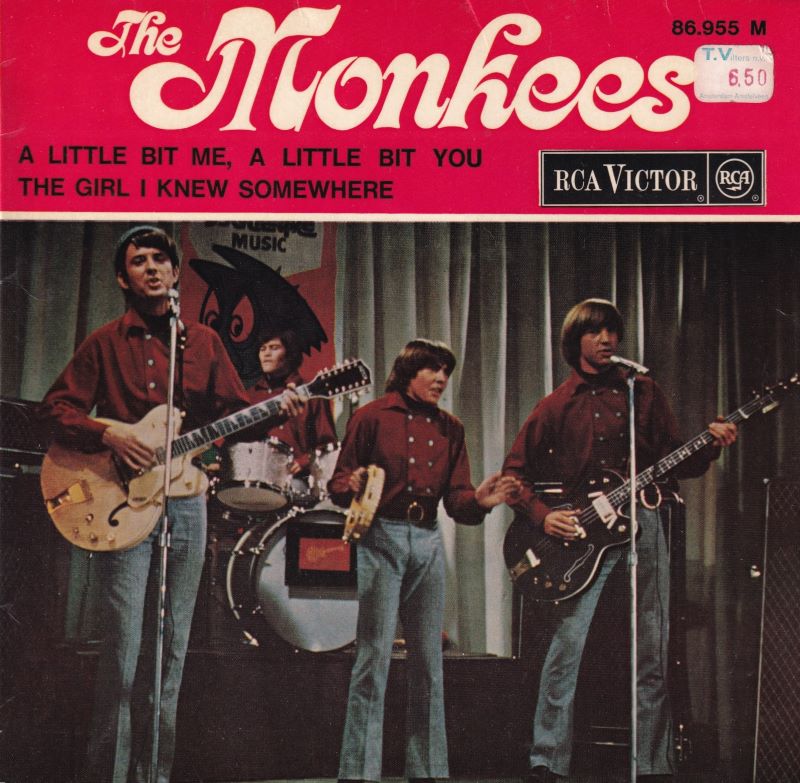Annual Lists: How it started
How it started
It is not easy to pinpoint my earliest musical memories. Of course, there must have been children’s songs in my early childhood, but they haven’t really stuck with me. What I do vaguely remember is that as a 3- or 4-year-old boy, I sang along to “Vous Permettez Monsieur” by the Belgian singer Adamo, who was very popular at the time. I looked it up and found that it was on the Dutch charts from February to July 1964, so it must have been played a lot on the radio then. Since it was in French, I obviously didn’t understand a word of it, and I remember singing the word “Mariage” as “maar een jasje” (which translates to “just a jacket”), much to the amusement of my parents. That must have been one of the earliest examples of a “Mama Appelsap” moment.
It must have been around the same time that the first music I still enjoy today made its entrance. Like millions of others, it was The Beatles who introduced me to the world of pop music. They were also the first artists whose music I physically owned—on vinyl, of course—and I’m happy to say I still have those records in my collection. I don’t know which single I got first or exactly when it happened. It was either “She Loves You” or “Twist and Shout”. I found online that “She Loves You” was recorded on July 11, 1963—on my third birthday, in fact—while “Twist and Shout” was recorded exactly five months earlier. But as far as I can tell, both songs only became true radio hits in 1964, with “She Loves You” seemingly gaining traction a bit earlier. Moreover, I have a faint memory of singing along to its chorus. “She Loves You, Yeah, Yeah, Yeah” is reasonably singable even for a Dutch toddler who doesn’t speak English, so I hereby officially declare this to be the starting point of my passion for music.
I must have been about four years old when that passion began, and as I write this, I am sixty-four. So, this madness has been going on for sixty years! Well, let’s just add another sixty years to that, shall we?
As promising as it began, those sixty years were not consistently great. There were about ten musically lean years early on. From those years, I still remember the beautifully melancholy “This Strange Effect” by Dave Berry from 1965 and “Cathy’s Clown” by The Everly Brothers, a song from my birth year, 1960, though my single was also from 1965. To my surprise, I can no longer find either of these singles in my collection, so the images I share now are sourced from the internet.
For music from 1965 onward, I have to go through the hit charts of those years. Doing so, I came across “Glaasje op, laat je rijden” by Sjakie Schram, which, incredibly, is still in my collection! I also found singles of Swiebertje, De Fabeltjeskrant, and an entire LP of Ja Zuster, Nee Zuster. There’s nothing wrong with children’s songs at that age, of course—they still evoke warm and happy memories for me today.
Other songs like “Shame and Scandal in the Family” by Shawn Elliott (1965) and “Beestjes” by Ronnie en de Ronnies (1967) were tracks we sang along to or imitated at home. Fun and cheerful, but musically, they didn’t mean much, of course.
Luckily, there was a brief “comeback” by The Beatles with “We Can Work It Out / Day Tripper” (1965 or ’66), but after that, The Fab Four largely faded into the background for me for at least ten years. Literally, in fact, as their music remained and still remains a staple as background music on the radio to this day. There was also “Give Peace a Chance” by the Plastic Ono Band in 1969, though I can’t remember whether I even realized what connection it had to The Beatles.
There is one other sixties band I must mention: The Monkees. Around 1967/68, I was genuinely a fan of them. Besides some vinyl records, I also had a comic book and always watched the TV show. Their formula was clearly modeled on The Beatles, but musically, they often delivered great songs. Tracks like “Daydream Believer,” “A Little Bit Me, A Little Bit You,” “Last Train to Clarksville,” and “I’m a Believer” still resonate with me today. In later years, I even bought a compilation CD of their work.
For me, the 1970s were, like for many of my contemporaries, the “years of awakening” musically. At the time, I loved to sleep in, so my musical awakening wasn’t exactly rapid either. Pop hits from those years were fun to listen to but rarely left a lasting impression.
Reviewing the Top 40 lists from those years, I find songs like “El Condor Pasa” by Los Incas (1970), which I believe my mother bought as a single, and “Soldiers Who Want to Be Heroes” by Rod McKuen (1971) and “Sacramento” by Middle of the Road (1972), both of which my father purchased. Also from 1972 was “Poppa Joe” by The Sweet. Whether I asked for that one or my dad bought it himself, I’m not sure, but my “Papa Joop” liked it, and so did I. My mother, on the other hand, was fond of “Non, Non Rien a Changé” by Les Poppys (1971), and I happily went along with her enthusiasm for it.
On the radio and TV, I listened to hits by Mouth & MacNeal, Les Humphries Singers, Lynsey de Paul, Partridge Family, Gilbert O’Sullivan, and Gerard Cox. All very innocent, and most of these songs still bring a smile to my face.
In 1973, the first songs that stirred deeper emotions in me appeared. These included feelings like being moved (though I had experienced that before with Ben Cramer’s “De Clown”), indignation, but above all, excitement. That year, for example, there was Chi Coltrane’s “Go Like Elijah,” “The Free Electric Band” by Albert Hammond, Earth & Fire’s “Maybe Tomorrow, Maybe Tonight,” and Redbone’s “We Were All Wounded at Wounded Knee.” I also enjoyed listening to The Osmonds, Carpenters, Mud, Sailor, and Paper Lace in ’73 and ’74, but often only a handful of their songs truly stuck with me.
In the early 1970s, the Eurovision Song Contest had already become a major influence on radio and TV. A few songs caught my attention, including those by Vicky Leandros, Cliff Richard, and especially “Eres Tú” by Mocedades, which I still consider one of the best Eurovision songs ever. In 1974, ABBA’s “Waterloo” became the clear winner and a true sensation. The next day, my best friend Frank (still my best friend to this day) and I rushed to the local record store to buy the single, but they didn’t have it in stock yet. As soon as it became available, we both bought a copy. I still have mine; Frank’s met a different fate, but more on that later.
As I liked more songs and wanted to hear them more often, I discovered the concept of hit compilations. Arcade and K-Tel released compilation LPs featuring a mix of songs I knew and loved, tracks I had heard but didn’t know by name, and some I had never heard before but discovered through those albums—sometimes to my delight, sometimes not.
I had two of these LPs, probably purchased at Makro or a similar store. Looking back now, I see that one of them already featured a song by Deep Purple, “Woman from Tokyo.” However, I don’t recall it making much of an impression on me at the time—it was likely still a year too early for that. ELO’s “Showdown” was also on there, but it would take years before I truly began to appreciate that band.
Other memories from 1974 come from the time I spent in the hospital that year. It might have only been a week or so, but there were several hits on the radio that I enjoyed. Paul McCartney & Wings were frequently played with “Band on the Run” and “Mrs. Vandebilt,” as well as “The Air That I Breathe” by The Hollies. These songs still remind me of my time in the hospital—not unpleasant memories, as once I started feeling better, it turned into quite a fun experience. I remember playfully spraying water at each other with syringes (without needles, of course) alongside some of the other young patients. Most of the nurses were great fun as well, making the experience more enjoyable.
That same year, I acquired my first full LP by a band: Kimono My House by Sparks. The hit song “This Town Ain’t Big Enough for the Both of Us” was so thrilling and exciting to me that I wanted the entire album. You can read more about it on the dedicated page under the “Defining Albums” tab.
In 1975, the musical explosion truly happened. The pop-rock single “Fox on the Run” by The Sweet marked my transition to real rock music—and immediately to hard rock! I must give full credit to Frank, who introduced me to 24 Carat Purple by Deep Purple. More about that can also be found on the dedicated page under the “Defining Albums” tab.
At that age, everything was black and white, with very few shades of gray. We made a rather drastic break with the pop music we had enjoyed until recently. Anything we deemed “commercial” was banned. Frank’s previously mentioned copy of “Waterloo” became our target: we used it as a frisbee until it broke! It was a sort of “rebellious” but primarily symbolic—and thankfully temporary—break from all the music we had previously listened to. Guitars needed to shred, drums had to pound, and singers were required to scream and wail.
Around this time, I also started making music lists of my favorite songs and albums. Initially, these lists were dominated by Deep Purple (“Black Night” live held the top spot for a long time), supplemented with some Uriah Heep, Led Zeppelin, and the occasional outlier. “Fox on the Run” made an early appearance in my song list, though Frank insisted it no longer belonged there. After a few weeks, I agreed it couldn’t stay.
There’s a slim chance I might find those very first lists again someday. If I do, I’ll certainly share them on this page, but it’s quite possible they’ve been lost to time. The oldest one I’ve been able to locate so far is an album list I compiled on December 15, 1979. You can see it below: my All-Time LP Poll from back then.
Honestly, I still think it’s a solid list. I clearly had a strong preference for live double albums, which is evident. The most surprising entry, in my opinion, is Word Salad by Fischer-Z at number 12. I now remember that I had received it just ten days earlier from my parents for Sinterklaas, which likely explains its high ranking. I should listen to that record again and see how I feel about it now.


Over the years, lists have continued to play an important role in my musical life, including wish lists, of course. On these pages, you’ll find annual album lists and possibly other types of lists as well. Sometimes they’ll reflect how I originally compiled them at the time—if I can still find them—but more often, they’ll be updated lists as I would create them now, given that I’ve since heard much more music and my taste has evolved.
Additionally, this will involve lots of listening and digging through my archives to create lists from earlier years, and I’m already looking forward to it!
On the subpages, accessible by clicking on a year in the right-hand sidebar, you can see the lists I’ve already posted for the corresponding years.


















